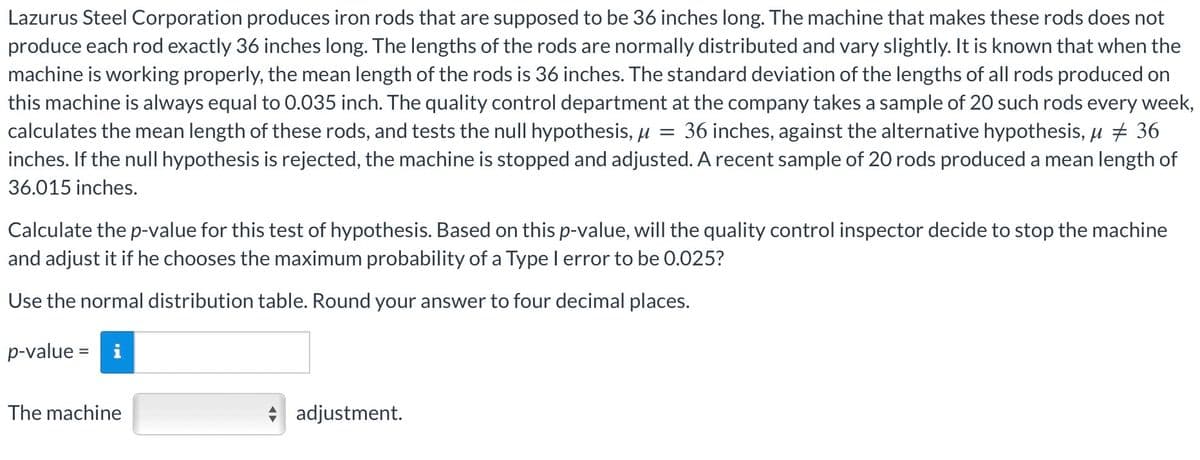Lazurus Steel Corporation produces iron rods that are supposed to be 36 inches long. The machine that makes these rods does not produce each rod exactly 36 inches long. The lengths of the rods are normally distributed and vary slightly. It is known that when the machine is working properly, the mean length of the rods is 36 inches. The standard deviation of the lengths of all rods produced on this machine is always equal to 0.035 inch. The quality control department at the company takes a sample of 20 such rods every week, calculates the mean length of these rods, and tests the null hypothesis, μ = 36 inches, against the alternative hypothesis, μ # 36 inches. If the null hypothesis is rejected, the machine is stopped and adjusted. A recent sample of 20 rods produced a mean length of 36.015 inches. Calculate the p-value for this test of hypothesis. Based on this p-value, will the quality control inspector decide to stop the machine and adjust it if he chooses the maximum probability of a Type I error to be 0.025? Use the normal distribution table. Round your answer to four decimal places. p-value = i The machine adjustment.
Lazurus Steel Corporation produces iron rods that are supposed to be 36 inches long. The machine that makes these rods does not produce each rod exactly 36 inches long. The lengths of the rods are normally distributed and vary slightly. It is known that when the machine is working properly, the mean length of the rods is 36 inches. The standard deviation of the lengths of all rods produced on this machine is always equal to 0.035 inch. The quality control department at the company takes a sample of 20 such rods every week, calculates the mean length of these rods, and tests the null hypothesis, μ = 36 inches, against the alternative hypothesis, μ # 36 inches. If the null hypothesis is rejected, the machine is stopped and adjusted. A recent sample of 20 rods produced a mean length of 36.015 inches. Calculate the p-value for this test of hypothesis. Based on this p-value, will the quality control inspector decide to stop the machine and adjust it if he chooses the maximum probability of a Type I error to be 0.025? Use the normal distribution table. Round your answer to four decimal places. p-value = i The machine adjustment.
Glencoe Algebra 1, Student Edition, 9780079039897, 0079039898, 2018
18th Edition
ISBN:9780079039897
Author:Carter
Publisher:Carter
Chapter10: Statistics
Section10.5: Comparing Sets Of Data
Problem 13PPS
Related questions
Question

Transcribed Image Text:Lazurus Steel Corporation produces iron rods that are supposed to be 36 inches long. The machine that makes these rods does not
produce each rod exactly 36 inches long. The lengths of the rods are normally distributed and vary slightly. It is known that when the
machine is working properly, the mean length of the rods is 36 inches. The standard deviation of the lengths of all rods produced on
this machine is always equal to 0.035 inch. The quality control department at the company takes a sample of 20 such rods every week,
calculates the mean length of these rods, and tests the null hypothesis, μ = 36 inches, against the alternative hypothesis, μ # 36
inches. If the null hypothesis is rejected, the machine is stopped and adjusted. A recent sample of 20 rods produced a mean length of
36.015 inches.
Calculate the p-value for this test of hypothesis. Based on this p-value, will the quality control inspector decide to stop the machine
and adjust it if he chooses the maximum probability of a Type I error to be 0.025?
Use the normal distribution table. Round your answer to four decimal places.
p-value = i
The machine
adjustment.
Expert Solution
This question has been solved!
Explore an expertly crafted, step-by-step solution for a thorough understanding of key concepts.
This is a popular solution!
Trending now
This is a popular solution!
Step by step
Solved in 2 steps with 3 images

Recommended textbooks for you

Glencoe Algebra 1, Student Edition, 9780079039897…
Algebra
ISBN:
9780079039897
Author:
Carter
Publisher:
McGraw Hill

Glencoe Algebra 1, Student Edition, 9780079039897…
Algebra
ISBN:
9780079039897
Author:
Carter
Publisher:
McGraw Hill